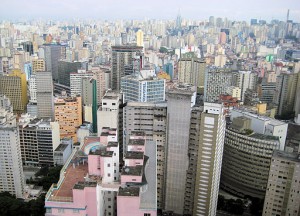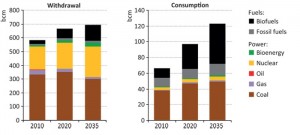Thirsty? A City of 20 Million People on the Verge of Running Out of Water
Oct 30th, 2014 | By admin | Category: Water IssuesBy Suzanne York, www.howmany.org
For several years now, the topic that water would be the next oil has been bandied about, implying that water would be as valuable as fossil fuels.

[Photo:By Francisco Anzola (Flickr: Sao Paulo Skyline) [CC-BY-2.0 (http://creativecommons.org/licenses/by/2.0)], via Wikimedia Commons]
U.S. Intelligence Weighs in on Water
In 2012, the U.S. Office of the Director of National Intelligence released a report which found overuse of water as a source of conflict that could potentially compromise U.S. national security. Here is the main conclusion:
Our Bottom Line: During the next 10 years, many countries important to the United States will experience water problems—shortages, poor water quality, or floods—that will risk instability and state failure, increase regional tensions, and distract them from working with the United States on important US policy objectives. Between now and 2040, fresh water availability will not keep up with demand absent more effective management of water resources. Water problems will hinder the ability of key countries to produce food and generate energy, posing a risk to global food markets and hobbling economic growth. As a result of demographic and economic development pressures, North Africa, the Middle East, and South Asia will face major challenges coping with water problems.
Water Needs – People vs. Industry
In California, the major drought continues. Citizens are urged to conserve water, as they should, but given that the agriculture industry uses 80% of the water in the state, that should be the prime target for water conservation. The state, industry and citizens need to rethink what type of crops are grown as the drought endures. Some of California’s top crops use tremendous amounts of water, especially almonds, rice, and cotton. And it is not just Big Ag using lots of water. According to The Economist, the silicon chipmaking industry is thought to account for 25% of water consumption in Silicon Valley. Additionally, water is needed to cool thermal power plants, plus livestock for eventual human consumption need lots of water (and eat hay and alfalfa, which are water-intensive crops).
Globally, a billion people, or one in seven on the planet, lack access to safe drinking water. Unfortunately, many of these people will be competing against industry for water. Earlier this year, the International Energy Agency determined that energy accounts for 15% of global water usage, and will consume ever more through 2035. The IEA stated that “Water is critical for electricity generation as well as the extraction, transport and processing of fossil fuels, even the irrigation of crops that go into biofuels.”

Global water use for energy production
[image credit: http://www.worldenergyoutlook.org/resources/water-energynexus/]
The world has a choice. We can continue with business as usual, and turn to even more water intensive forms of extraction – fracking and tar sands – or invest in and deploy clean energy sources like wind and solar. Increasing biofuels usage set up a food vs. fuel dynamic, and now we are going in the same direction with water for humans vs. water for industry.
For what it’s worth, you can determine how big your water footprint is and consider how much of your diet is impacted by high water usage (definitely cows, but also yogurt, for example).
Suzanne York is a senior writer with the Institute for Population Studies.
